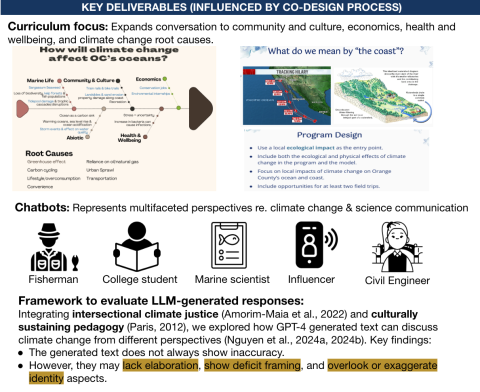Body
Image

Equity-Centered Design Of Conversational Agents For Climate Change Communication
We are presenting on Year 1 of a three-year, NSF-funded project (2023-2026) entitled Agents for Inclusive Science Communication (AISciComm). The project involves a research-practice partnership between University of California-Irvine, Utah State University, and Orange County Department of Education. Our main goal is to support high school students (grades 9-12) in Title I schools in Orange County (OC), California to develop systems understanding that (1) reflects how climate change will impact the local marine ecosystems, and (2) integrates the perspectives of community stakeholders. To these goals, we have co-designed different AI chatbots with high school teachers, students, and informal science educators. Using GPT-4 as the base model, the chatbots represent various community perspectives -- that students interact with in open-ended exchanges to refine their systems models. Students also develop their own AI-integrated products to represent their thoughts on climate change topics. These activities prompt students to consider human-centered factors often overlooked in systems models of climate change, as well as develop understanding of inclusive science communication and AI literacy.
Pillar 1: Innovative Use of Technologies in Learning and Teaching
We have developed AI chatbots (GPT-4 as the base model) to represent community perspectives, and learning activities about marine ecosystems, science communication, and AI literacy. We have also developed a framework encompassing intersectional climate justice and culturally sustaining pedagogy perspectives, to evaluate and refine the prompts for GPT-4 to convey scientifically accurate, locally grounded, and diverse perspectives without bias.
Pillar 2: Partnerships for Career and Workforce Preparation.
The phenomena that students investigate—impacts of human activities on ecosystems and community-wide climate actions—represent complex environmental challenges faced by communities beyond coastal California. Communicating about these issues can perpetuate inequities if the communication approaches do not account for the voices of marginalized populations. We examine the routines and principles that facilitate participation and agency among co-design participants.
Pillar 3: Strategies for Equity in STEM Education
Building on inclusive science communication and equity-centered RPP, we utilized participatory approaches to design and evaluate the chatbots and learning activities. We conducted 8 co-design sessions with a team of students, formal and informal science educators, and researchers. We conducted interviews with community members to evaluate the AI output. Our research provides insights into how youth leverage their cultural, social, and personal identities in CA interactions, and how these interactions shape learning.

Discipline(s)
Environmental sciences
Emerging Tech (Artificial Intelligence, Quantum Computing, and Blockchain)
Target Gradespan(s)
High school (9-12)
Target Participant(s)
Youth / students
Educators
Project Setting(s)
Formal Education
Category
Exploring Theory and Design Principles (ETD)